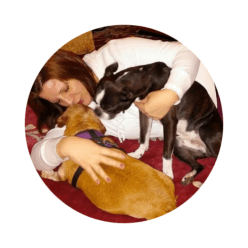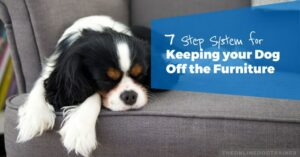Bringing home a new puppy is exciting, but your home can be full of hidden hazards. When it comes to puppy proofing your house, you have to remember that puppies are naturally curious and love to chew, sniff, and explore places they shouldn’t—which can lead to accidents or injuries.
In this post, we’ll cover:
-
- 10 Ways to Puppy Proof Your Home
- Puppy Proofing Your Yard
- How to Puppy Proof Wires
- How to Puppy Proof Your Furniture
- Recommendation for Puppy Training
- Additional Puppy Proofing and Puppy Care Resources
This post contains affiliate links. If you make a purchase, I’ll earn a commission (at no extra cost to you). As an Amazon Associate, I earn from qualifying purchases. I donate 10% of my profits to animal charities.
Puppy Proofing Checklist
This checklist will help you identify and fix the most common dangers in your home to ensure your puppy is safe, happy, and protected.
1. Hide Electrical Cords
Puppies love to chew—and cords can cause burns or electrocution. Use cord covers or tuck cords behind furniture (more on this later).
2. Block Off Unsafe Rooms
Use baby gates or closed doors to keep puppies out of garages, staircases, laundry rooms, and other unsafe areas.
3. Store Medications Securely
Keep all medications (human and pet) in cabinets out of reach. Even over-the-counter items can be deadly to dogs.
4. Secure Trash Cans
Use a bin with a locking lid or place it in a closed cabinet to prevent your pup from eating something toxic. For more help on this, read my post, How to Keep the Dog Out of the Garbage (includes video). It’s not just the mess if your puppy gets into the garbage. It can be dangerous because they could choke on something or eat something they shouldn’t!
5. Remove Small Objects from Floors
Coins, batteries, hair ties, socks, and toys can be choking hazards. Get on the floor and scan from a puppy’s eye level. I have a friend who didn’t realize she dropped a very strong heart medication pill on the floor – if one of her pets had eaten it, it probably would’ve been fatal.
6. Keep Houseplants Out of Reach
Many common plants (like lilies and philodendrons) are toxic to dogs. Move them to higher shelves or choose pet-safe varieties.
7. Install Cabinet Locks
Installing cabinet locks, especially in the kitchen and bathroom, will block access to cleaners, chemicals, and sharp items.
Hey…I think I need to do this for my cat, Whiskers. He’s not a baby; he’s four years old. But if he gets hungry, he’ll open the kitchen cupboard where his food is and slam it shut repeatedly! It’s happened many times…I’m woken up in the middle of the night with Bang! Bang! Bang! Starvin’ Marvin banging on the cupboards!
Ok…back to puppies…
8. Wrap or Clip Window Blind Cords
Window blind cords and drawstrings pose a strangulation risk. Use cord wraps or clips to keep them short and out of reach. I only found out about this one recently. It never occurred to me that the window blind cords or the drawstrings we use for drapes could be dangerous to pets until I heard about someone’s cat being strangled by them. It breaks my heart into a million pieces.
9. Pick Up Laundry and Shoes
Clothing and shoes often smell like you, which attracts chewing. Keep them in closets with doors shut. Always make sure your puppy has plenty of puppy-safe chew toys to help keep them away from your stuff! (More on puppy chewing later).
10. Secure Toilets and Lids
To prevent drinking or falling in, keep toilet lids closed. Some owners use puppy-proof toilet locks.
Speaking of toilets – I know someone whose puppy destroyed like 10 (I’m not kidding) toilet brushes! The puppy had a thing for chewing plastic and he’d go into the bathroom, grab the toilet brush and destroy it! Over and over again the owner had to buy a new one.
Just between you and me…I think by the second time it happened the person should’ve wised up and put the new toilet brush somewhere where this puppy couldn’t get it…but that’s just me….LOL
Puppy Proofing Your Yard
Bringing your puppy outside is a joy—but it also opens up a whole new set of hazards you might not expect. Even a well‑fenced yard can hide dangers like loose garden tools, toxic plants, or gaps under fences that a curious puppy will exploit (or get their head stuck in).
Before letting your pup roam free, walk the perimeter, scan for escape routes, and remove or secure anything chewable, climbable or hazardous. This ensures your yard becomes a safe play zone rather than a worry zone.
Just as it’s important to puppy‑proof the yard, it’s equally vital to view your outdoor space with the same scrutiny you apply indoors.
For a deeper dive into both home and yard safety for pets, check out my full checklist here: Pet Safety for Home and Yard. From water features and window screens to garden toxins and fencing repairs, this guide will help you leave no stone unturned when it comes to your puppy’s safety.
How to Puppy Proof Wires
Electrical wires are one of the most dangerous chewing temptations for puppies, especially during teething. Start by identifying all exposed cords at your puppy’s level—this includes behind furniture, along baseboards, and under desks.
Use cord management tools like plastic tubing, cord concealers, or heavy-duty cable sleeves to fully encase the wires. For chargers or lamps, route cords behind furniture or up and away from floor level using adhesive clips or wall mounts.
To discourage chewing behavior, apply a pet-safe bitter deterrent spray directly onto wires (test for staining first). Provide safe chew toys nearby to redirect your puppy’s urge to gnaw. If there are areas where cords can’t be secured, block them off entirely using baby gates or exercise pens.
Never leave your puppy unsupervised in areas where exposed cords are within reach. This simple prevention step protects your puppy from burns, electric shock, or worse.
Also refer to my post, How to Stop Puppy Chewing Step-by-Step (includes video).
How to Puppy Proof Furniture
Puppies love to climb, chew, and explore—and that often means your furniture becomes a target. To protect couches and chairs, use washable covers or pet-friendly throws that are easy to remove and clean.
For wooden furniture, apply bitter deterrent sprays to chair legs and low tables to discourage chewing. Keep items like remote controls, shoes, and throw pillows off the furniture to reduce temptation.
If your puppy is constantly jumping on furniture you’d prefer to keep off-limits, consistency is key. Block access to certain rooms when you’re not around. And most importantly, train your puppy with calm, positive reinforcement.
For help, check out this free tutorial from Professional Dog Trainer, Doggy Dan called, 7 Steps to Keep Your Dog Off the Furniture. His gentle methods can make a huge difference without stress or punishment.
More Information on Making Your Home Pet Friendly
Check out my post Making Your Home Pet Friendly- Beyond the Basics for many more tips on making your home safe for your puppy and other pets. In that post, I cover what a pet-friendly home really means, pet proofing your home for safety and for comfort, and making your home a place where your pets can live happy, healthy lives!
Recommendation for Puppy Training
My best recommendation for puppy training is an all-in-one program from Professional Dog Trainer and Behavioral Specialist, Doggy Dan. It includes a complete puppy training program plus free, step-by-step puppy potty training videos!
👉 Fix bad puppy behavior fast with The Puppy Coach!
More Help with Caring for a Puppy
- Preparing for a Puppy: What to Do Before Bringing Your Puppy Home
- How to Get Ready for a New Puppy: Checklist
- Establishing a Routine for Your Puppy: Consistency Is Key
- Why Do Puppies Sleep So Much?
- Bringing Your New Puppy Home: Preparing Your Family
- First-Time Vet Visit for Your Puppy: How to Prepare and What to Expect
Congrats on Your New Puppy!
Bringing home a new puppy is one of the happiest moments of your life—and making their world safe is the very best way to start. By taking the time to puppy proof your home and yard, manage wires and furniture, and create a secure environment both indoors and outdoors, you’re giving your puppy the safest possible beginning.
You should know I will receive a small commission if you purchase products from my site (like from Amazon or the dog training products mentioned in this post) using my links. I donate 10% of my profits to the animal charities listed here. Thank you for helping support PeopleLovingAnimals.com! Debra
More Puppy Proofing Tips for Your Home and Yard
For more information about puppy proofing your home, check out this post from the American Kennel Club, Puppy Proofing Tips for Your Home and Yard. In that post, they cover proofing indoors and puppy proofing outdoors.









